Stewart J. College Algebra: Concepts and Contexts
Подождите немного. Документ загружается.

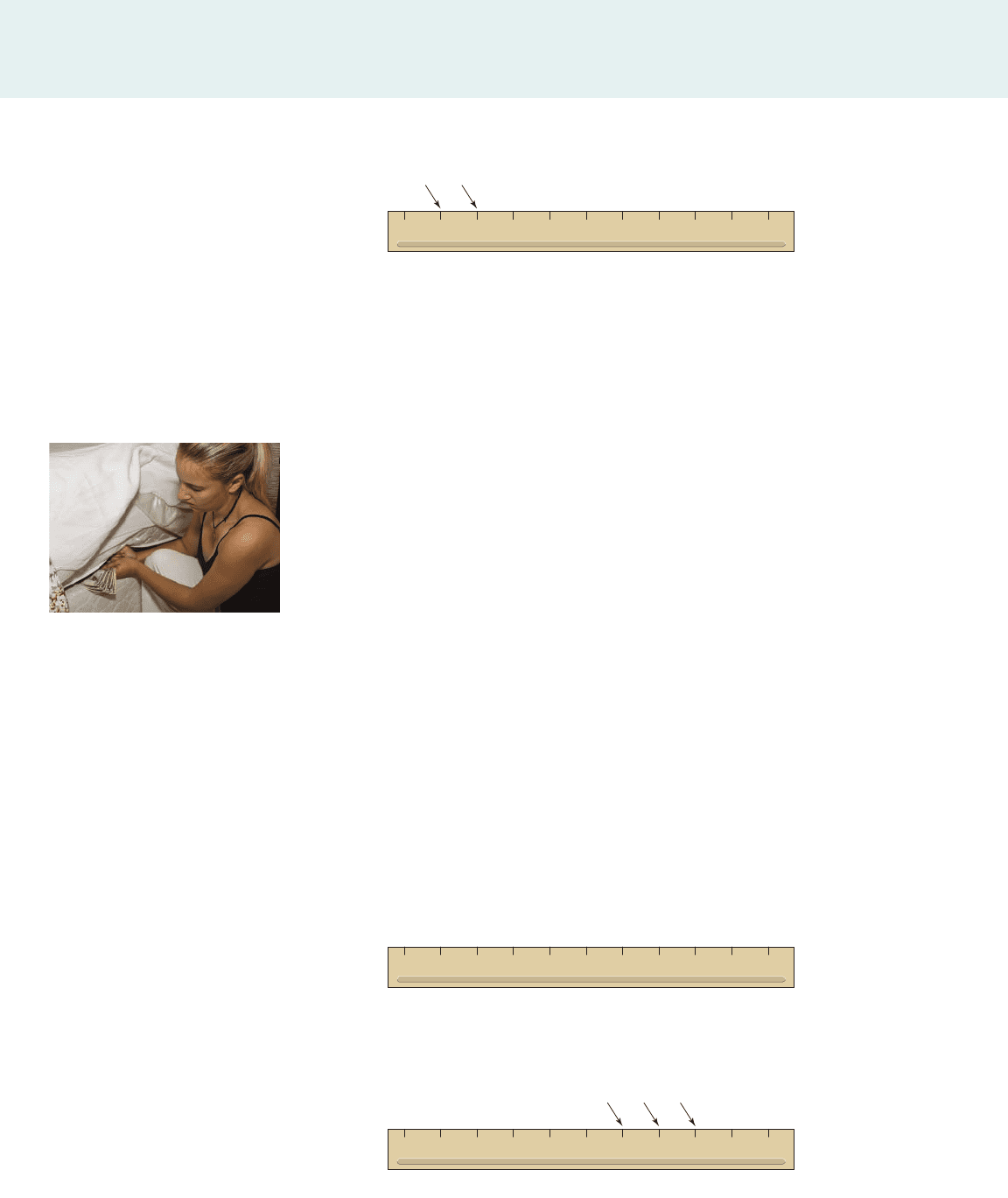
(a) Where is the one thousand dollar mark on the logarithm ruler? Where is
the ten thousand dollar mark?
(b) Where are the one million and one billion dollar marks on the ruler?
(c) Is there a one dollar mark on the ruler?
(d) Is the logarithm ruler too long to handle easily? Can the ruler be easily
used to measure small numbers of dollars?
4. In Questions 1–3 we used graphical methods to help us understand the differ-
ence in size between a million dollars and a billion dollars. Now let’s use
another method.
(a) Suppose you have one million dollars under your mattress (you don’t trust
banks). Each day you take out one thousand dollars and spend it. For how
many years would you be able to maintain this lifestyle before you
become totally broke?
(b) If you have a billion dollars (instead of a million) in part (a), how many
years would pass by before you would be broke?
II. How Small Is a Bacterium?
We’ve talked a lot about bacteria in this book. Let’s compare the size of a bacterium
with other, more familiar things. Recall that a centimeter (cm) is one hundredth of a
meter (m), a millimeter (mm) is a thousandth of a meter, and a micrometer (mm) is
a millionth of a meter.
Small child 1 m
Housefly 1 cm
Mite 1 mm
Bacterium 1 mm
1. To visually compare the size of the living things in the above list, let’s use a
meter stick. Mark the size of each one on the meter stick below.
Money under the mattress
0
Meter stick
1 m
_7 _6 _5 _4 _3 _2 _1 0 1 2
10–¡ 10º 10¡
Lo
g
arithmic meter stick
3
EXPLORATIONS
■
EXPLORATIONS
■
EXPLORATIONS
■
EXPLORATIONS
404 CHAPTER 4
0123456789
10¡
10™
The lo
g
arithm ruler
10
cbarnesphotography/Shutterstock.com 2009
2. Some of the marks you put on the meter stick in Question 1 are not easily
distinguishable. Let’s use the logarithmic meter stick shown below.
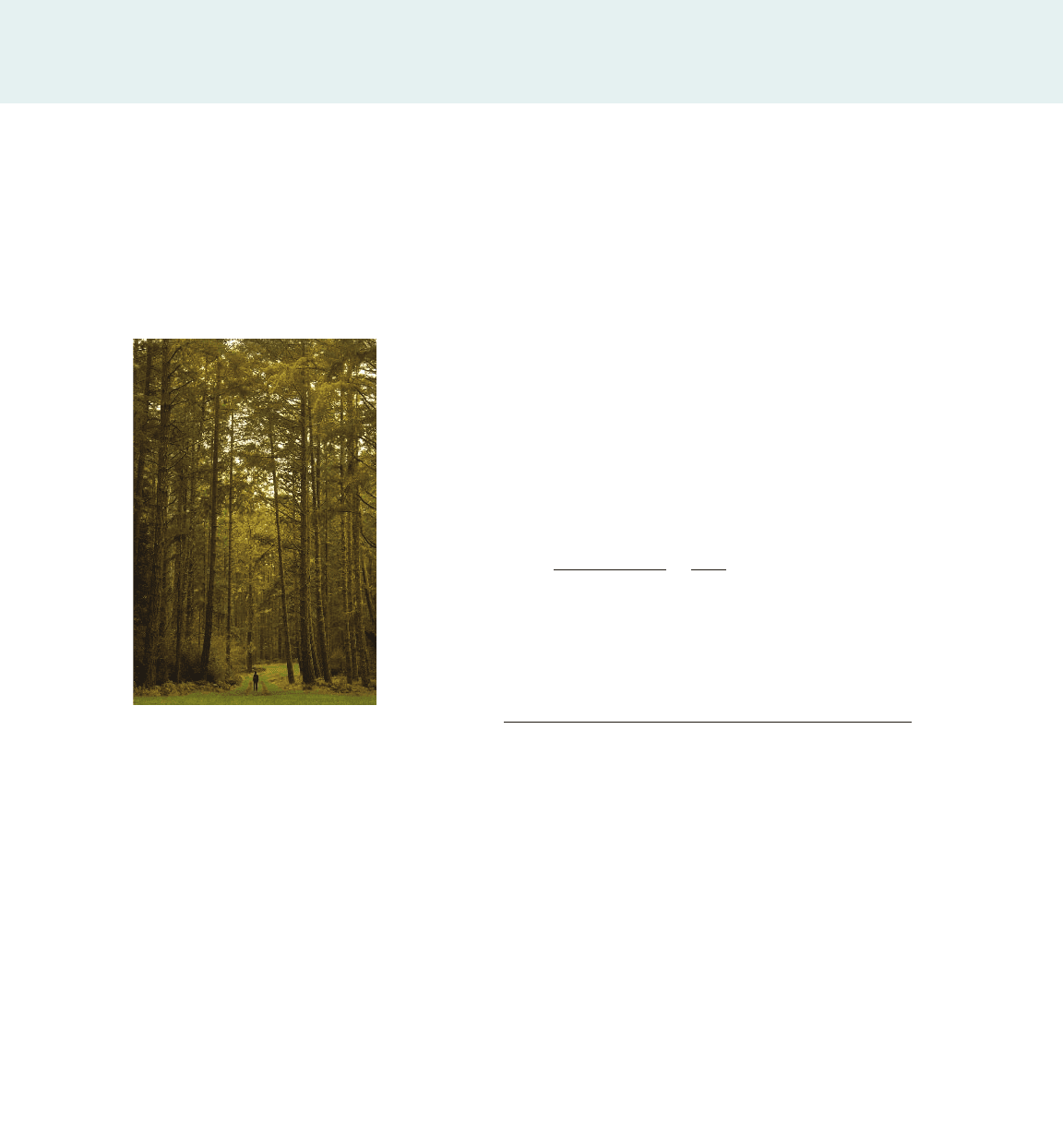
(a) Express the size (in meters) of each of the living things on the list on the
preceding page in exponential notation.
(b) Label the size of each object on the logarithm meter stick.
(c) Where would a 10-meter tree and a 100-meter tree land on the loga-
rithmic meter stick?
III. Orders of Magnitude
Sometimes we want to make rough size comparisons. To do this, we round off num-
bers to the nearest power of 10. For example, for a man who is 6 feet tall, we round
his height to 10 feet. In other words, the height of the man is closer to feet than
to feet (or 1 foot). For a ladybug that is feet long, we round its length
to feet. A number rounded to the nearest power of 10 is called an order of mag-
nitude. The idea is that an object that is 10 times or so larger than another object is
in a different category or “order of magnitude.”
To compare the height of a human being ( feet) to the height of a ladybug
( feet), we find the ratio:
So a human being is roughly or 1000 times larger than a ladybug. We say that a
human being is 3 orders of magnitude (three powers of 10) greater than a ladybug.
1. Express the following in terms of order of magnitude.
Object Size (m) Order of magnitude
Gold atom ________
Bacterium ________
Mite ________
Ladybug ________
Human ________
Earth ________
Sun ________
Betelgeuse ________
2. Perform the following order of magnitude comparisons using the results of
Question 1.
(a) The sun is _______ orders of magnitude larger than the earth.
(b) A bacterium is _______ orders of magnitude larger than a gold atom.
(c) A lady bug is _______ orders of magnitude smaller than the earth.
(d) Betelgeuse is _______ orders of magnitude larger than a bacterium.
8.3 * 10
11
1.4 * 10
9
1.3 * 10
7
1.8 * 10
0
7.0 * 10
-3
2.0 * 10
-3
3.5 * 10
-6
2.8 * 10
-10
10
3
human height
ladybug length
=
10
1
10
-2
= 10
1 -1-22
= 10
3
10
-2
10
1
10
-2
9.0 * 10
-3
10
0
10
1
EXPLORATIONS
■
EXPLORATIONS
■
EXPLORATIONS
■
EXPLORATIONS
EXPLORATIONS 405
A tree is one order of magnitude
taller than a human.
10
⫺3
10
⫺2
10
7
10
9
2
Cate Frost/Shutterstock.com
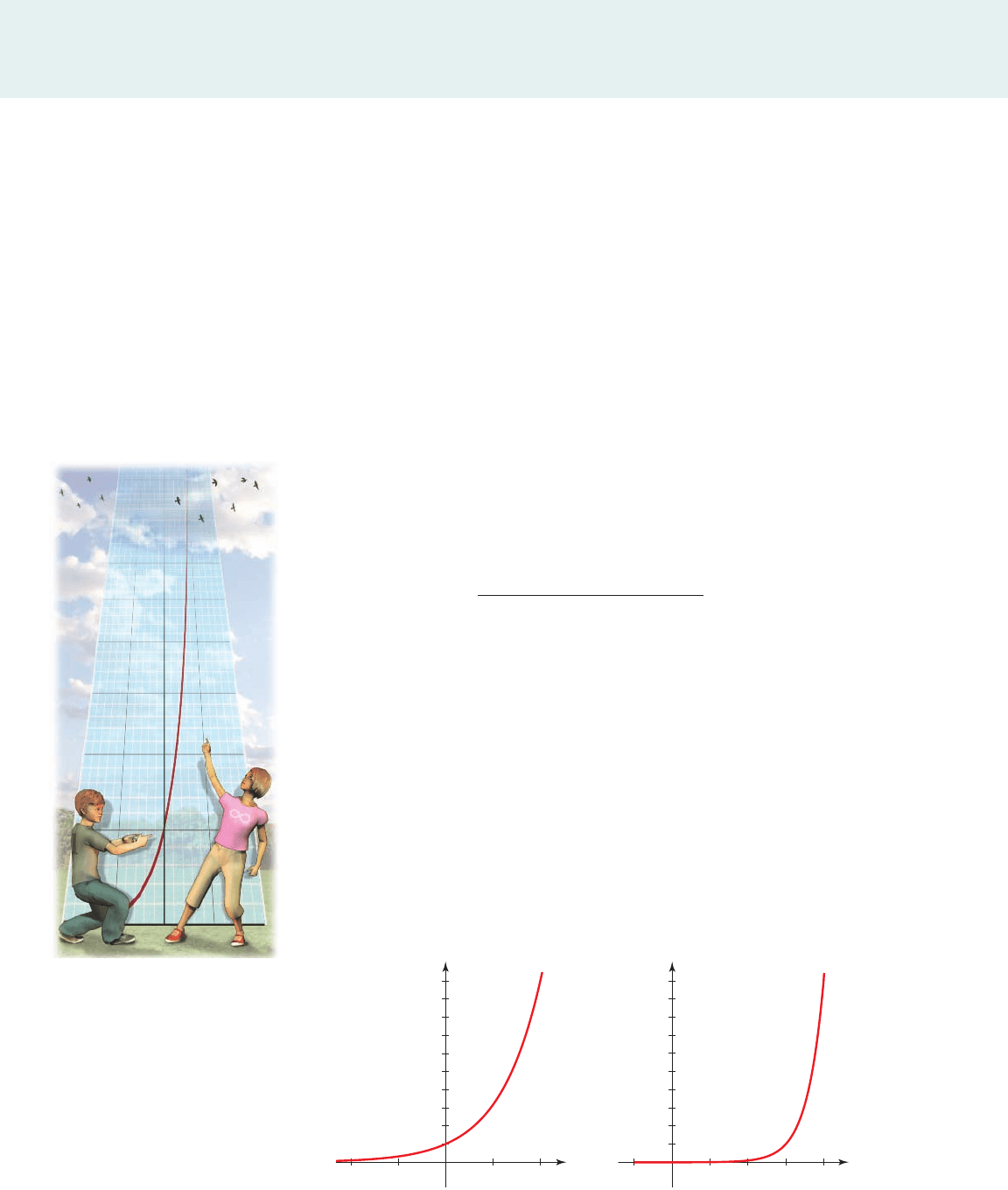
Semi-Log Graphs
OBJECTIVE To make semi-log graphs and use them to find models of exponential
data.
In Chapter 3 we sketched graphs of exponential functions. But in each case we
sketched only a small portion of the graph. This is because exponential functions
grow so rapidly that we would need a sheet of paper larger than the pages of this book
to sketch them, even for relatively small input values. In this exploration we see how
logarithms can be used to help us manage the size of such large graphs. In the process
we’ll discover how logarithms allow us to “straighten” exponential graphs, helping
us to analyze their properties as easily as we analyze lines.
I. How Big Is the Graph?
Let’s see what size sheet of paper we need to sketch a graph of
for x between 0 and 8.
1. For the function f, the input values of 0 and 8 correspond to what output values?
Input value Output value
0 _______
8 _______
2. Let’s make each unit on our graph to be 1 inch. So we need just 8 inches for
the x-axis, which is the width of the pages of this book.
(a) How many inches would we need for the y-axis?
(b) To get a better idea of how long the y-axis needs to be, convert your
answer to part (b) into miles.
(c) Would you be able to see the whole graph at once?
3. What if we decide to let each inch on the y-axis represent 1000 (or ) units?
(a) How many inches would we need for the y-axis?
(b) Convert your answer to part (b) into miles.
(c) Would you be able to see the whole graph at once?
4. Two graphs of f are shown below. Which graph can be used to estimate the
values of ? ? ? ?f 1- 0.92f 13.12f 12.3 2f 10.52
10
3
f 1x2= 10
x
3
x
0
y
y
0.5 1.0_0.5_1.0
2
4
6
8
10
x
0
3241_1
2000
4000
6000
8000
10,000
EXPLORATIONS
■
EXPLORATIONS
■
EXPLORATIONS
■
EXPLORATIONS
406 CHAPTER 4
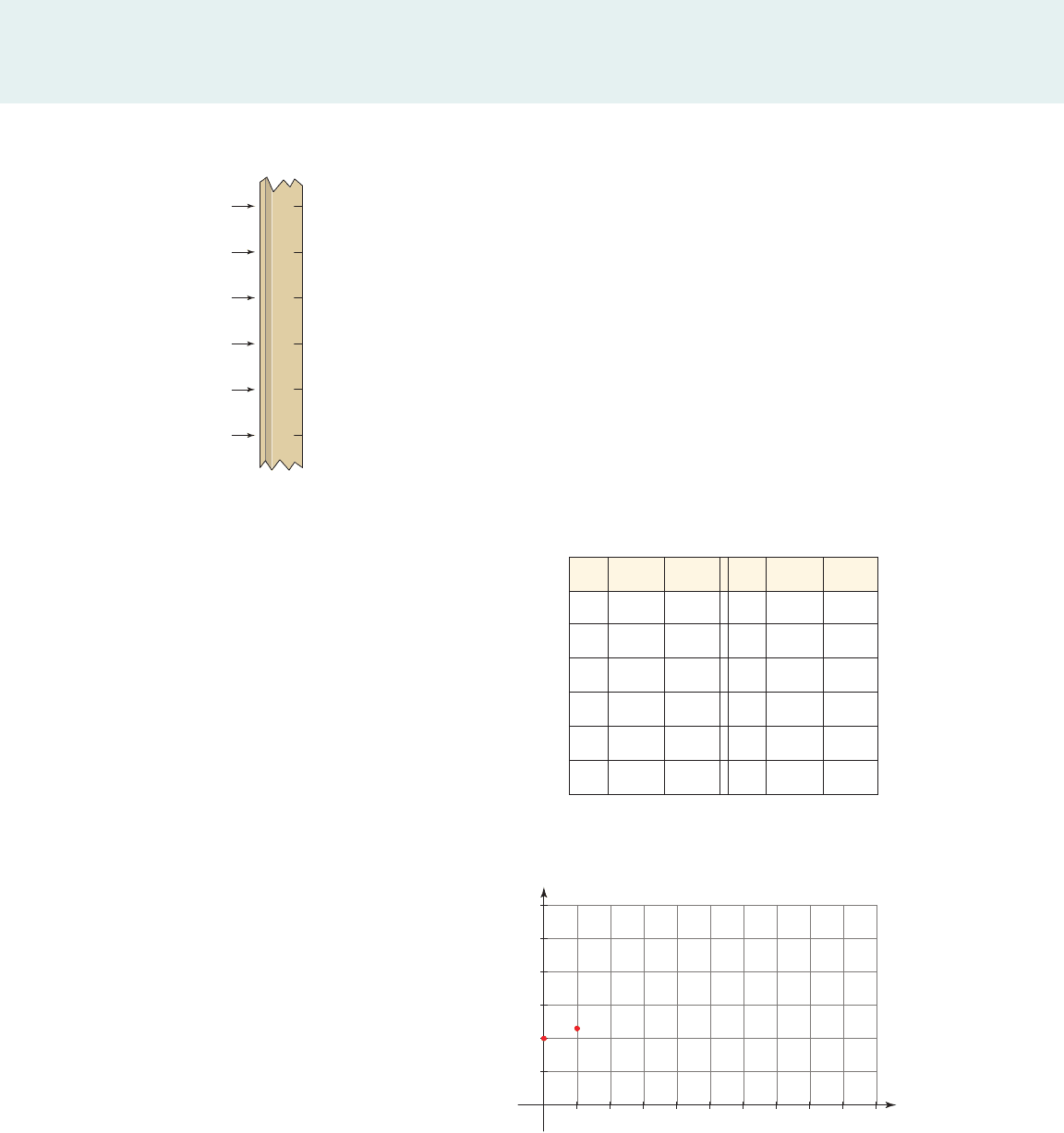
II. Semi-Log Graphs
None of the graphs we considered in Part I give a satisfactory representation of an
exponential function. One way around this dilemma is to use a “logarithmic ruler”
or logarithmic scale on the y-axis. (See the figure in the margin.)
When we graph a function and use a logarithmic scale on one of the axes, the
resulting graph is called a semi-log graph or semi-log plot. This is equivalent to
graphing the points (x, log y).
■
To draw a graph of f, we plot the points (x, y).
■
To draw a semi-log graph of f, we plot the points (x, log y).
Let’s sketch a semi-log graph of the exponential function
for x between 0 and 10.
1. Complete the table for the values of y and log y
y = 100
#
2
x
EXPLORATIONS
■
EXPLORATIONS
■
EXPLORATIONS
■
EXPLORATIONS
EXPLORATIONS 407
x y log y
0
100 2
1
200 2.3
2
3
4
5
x y log y
6
7
8
9
10
2. Draw a semi-log graph of f by plotting the points (x, log y) from the table in
Question 1.
x
y
1
2
3
4
5
6
12345678910
0
3. Does the semi-log graph appear to be a line? If so, estimate the slope and the
y-intercept from the graph.
Slope: _______ y-intercept: _______
The marks on the “logarithmic
ruler” are the logarithms of the
numbers they represent.
0
10º
10¡
10™
10£
10¢
10∞
1
2
3
4
5

4. Let’s show that the graph in Question 2 is a line by finding an algebraic
formula for log y.
(a) Supply the missing reasons.
Definition of y
Take log of each side
______________
______________
(b) The last equation in part (a) shows that log y is a linear function of x.
What is the slope? What is the y-intercept? Do your answers agree with
the line in the graph you sketched in Question 2?
III. Linearizing Data
A semi-log graph of an exponential function is a line. We can see this from
the following calculations:
Exponential function
Take the log of each side
Laws of Logarithms
To see that log y is a linear function of x, let , , and ;
then
So if we make a semi-log graph of exponential data, we would get a line with the fol-
lowing properties:
Slope: M ⫽ log a
y-intercept: B ⫽ log C
Let’s see how we can use this information to obtain a function that models expo-
nential data.
1. The following data are exponential. Note that the inputs are not equally
spaced.
Y = B + Mx
B = log CM = log aY = log y
log y = log C + x log a
log y = log Ca
x
y = Ca
x
y = Ca
x
log y L 2 + 0.3x
log y = log 100 + x log 2
log y = log1100
#
2
x
2
y = 100
#
2
x
EXPLORATIONS
■
EXPLORATIONS
■
EXPLORATIONS
■
EXPLORATIONS
408 CHAPTER 4
x y log y
0 10
0.5 20
2.0 160
3.0 640
4.5 5120
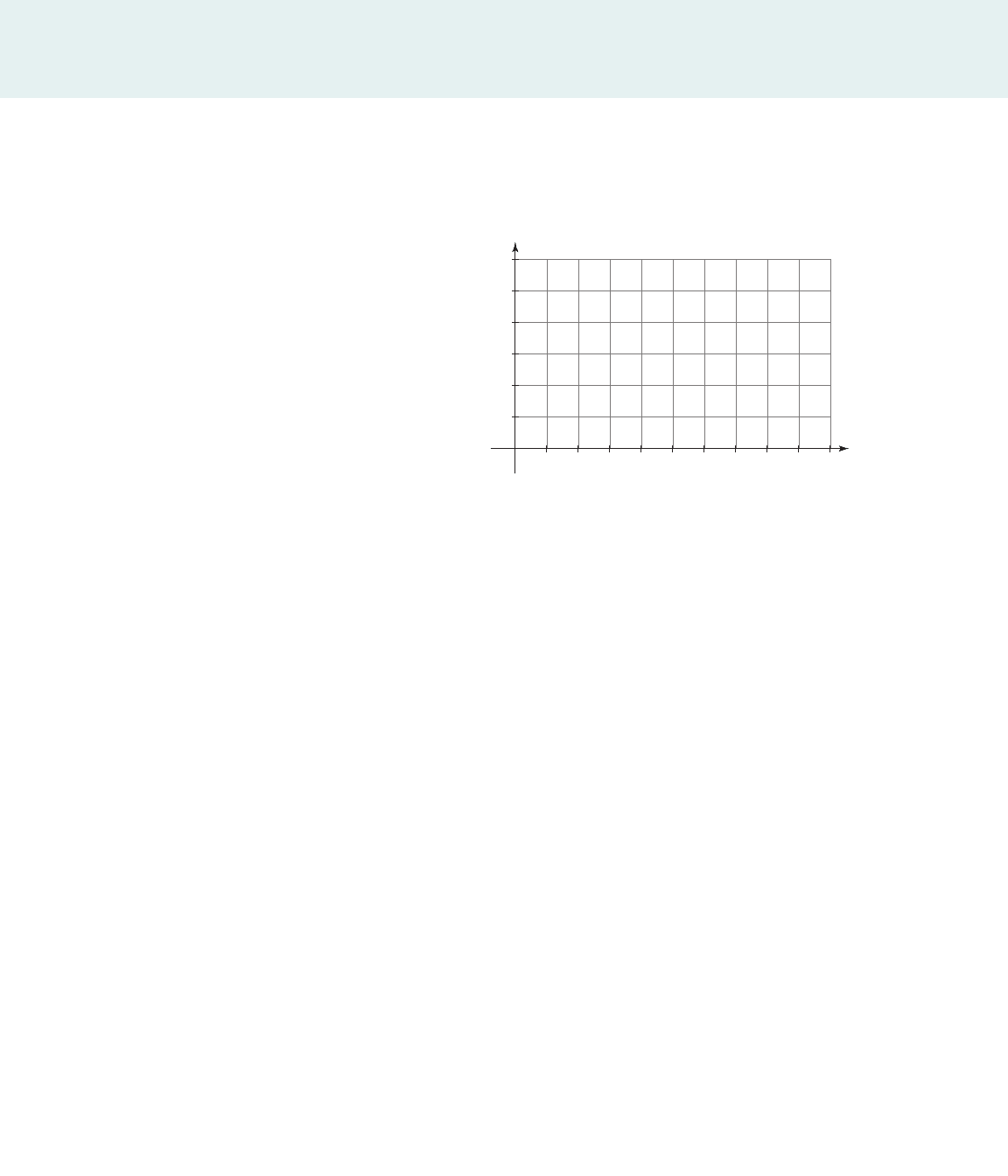
(a) Complete the log y column in the table.
(b) Make a semi-log graph of the data.
4
x
y
1
2
3
4
5
6
12345678910
0
EXPLORATIONS
■
EXPLORATIONS
■
EXPLORATIONS
■
EXPLORATIONS
EXPLORATIONS 409
2. Let’s find a function of the form that fits the data. (In other words, we
need to find a and C.)
(a) Estimate the slope and y-intercept from the graph.
Slope: M ⫽ _______
y-intercept: B ⫽ _______
(b) From the above we know that and . So
log a ⫽ _______
log C ⫽ _______
(c) Solve the equations in part (b).
a ⫽ _______
C ⫽ _______
(d) So a function that fits the data is
x
(e) Check that the values of the function you found in part 2(d) agree with the
data.
y =
ⵧ
#
ⵧ
B = log CM = log a
y = Ca
x
The Even-Tempered Clavier
OBJECTIVE To learn how musical scales are related to exponential functions and how
exponential functions determine the pitch to which musical instruments are tuned.
Poets, writers, philosophers, and even politicians have extolled the virtues of music—
its beauty, its power to communicate emotion, and even its healing power. The philoso-
pher Nietzsche said that “without music life would be a mistake.” Perhaps that’s why
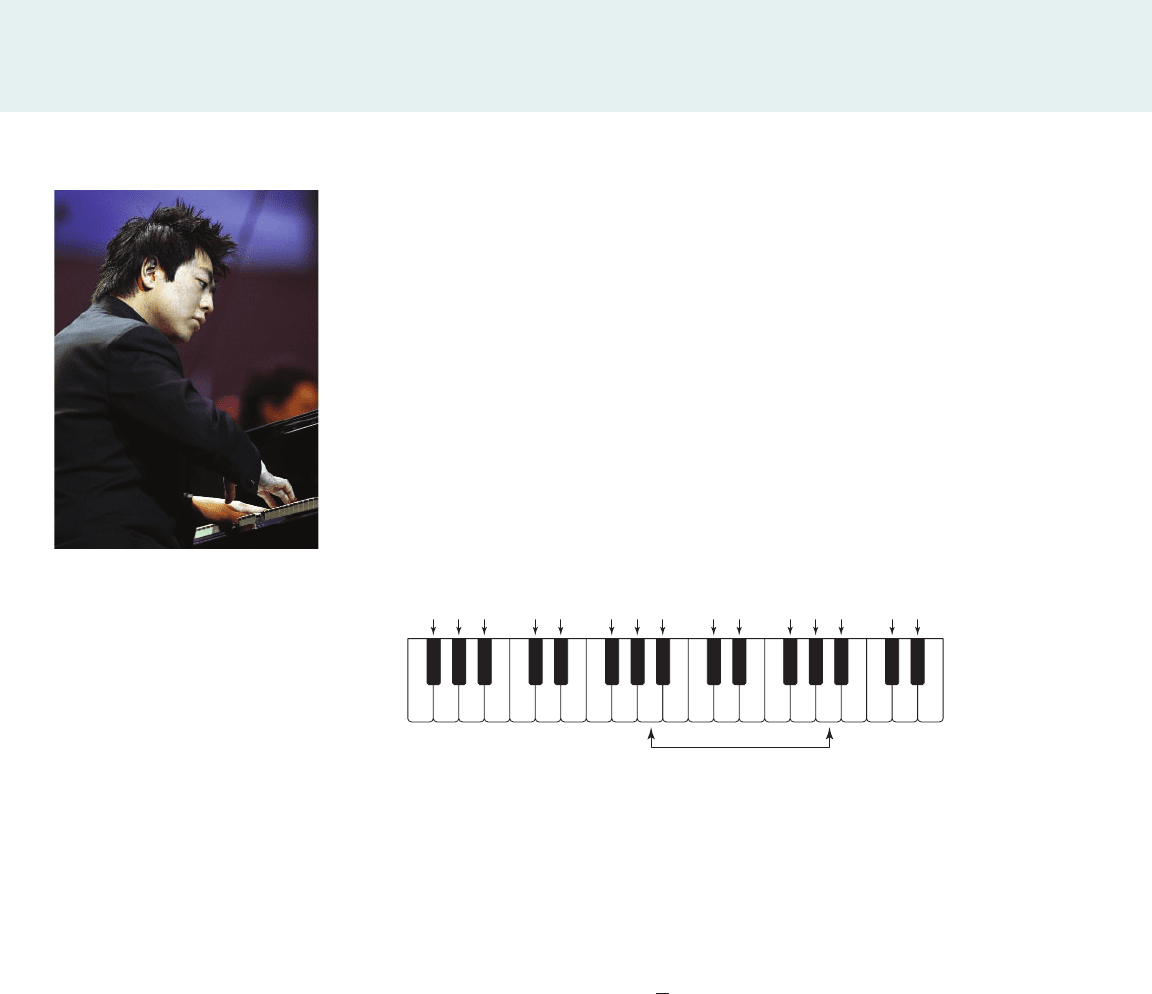
EXPLORATIONS
■
EXPLORATIONS
■
EXPLORATIONS
■
EXPLORATIONS
410 CHAPTER 4
Classical pianist Lang Lang
F
F#
GABC CDEFGAB DE
One octave
FGABCDE
G# A# C# D# F# G# A# C# D# F# G# A# C# D#
some musicians—from rock stars to classical pianists—can command huge fees for
performing their art.
What is music, exactly? Is it just “noise” that happens to sound nice? In general,
music consists of tones played by instruments or sung by voices, either sequentially
(as a melody) or simultaneously (as a chord). Tones, the building blocks of music,
are sounds that have one dominant frequency.
The tones that we are familiar with from our everyday listening can all be re-
produced by the white and black keys of any properly tuned piano. The strings of a
piano produce specific sound frequencies; for instance, middle A has a fundamental
frequency of 440 cycles per second, or 440 Hertz (Hz). The other “A” keys on the pi-
ano are either higher-sounding, with frequencies of 880 Hz, 1760 Hz, and so on, or
lower-sounding, with frequencies of 220 Hz, 110 Hz, 55 Hz, and so on. To get from
one A to the next, you just need to double or halve the frequency. Every pair of notes
with the same letter name “sounds” the same to most listeners. Such notes are said
to be separated by “octaves” on the musical scale. In this Exploration we learn how
exponential functions allow us to create all the notes in the musical scale.
ROBERT VOS/AFP/Getty Images
I. Frequencies of Notes
We divide the interval between two notes that are an octave apart into 12 parts in such
a way that each note’s frequency is a fixed multiple of the preceding one. This fre-
quency interval is called a semitone in music theory. Since an octave involves mul-
tiplying the frequency by 2, each semitone therefore involves multiplying the fre-
quency by . This means that the frequencies are evenly spaced on a logarithmic
scale. The distance between semitones on a logarithmic scale is
So the keys on a piano are “evenly tempered” on a logarithmic scale.
1. The note immediately above middle A is A sharp (A# or B
), then the note
above A# is B, and so on. The frequency of each note is obtained by multi-
plying 440 (the frequency of middle A) by an appropriate power of . We
have
A
A#
B
Complete the following table by calculating the frequencies of the notes pro-
duced by the keys in one octave on a piano, from middle A (known by piano
tuners as A4 or A440) to the next A (called A5).
440
#
12
1>12
2
2
L 493.883 Hz
440
#
12
1>12
2
1
L 466.164 Hz
440
#
12
1>12
2
0
= 440 Hz
2
1>12
log 2
1>12
=
1
12
log 2 L 0.025
2
1>12
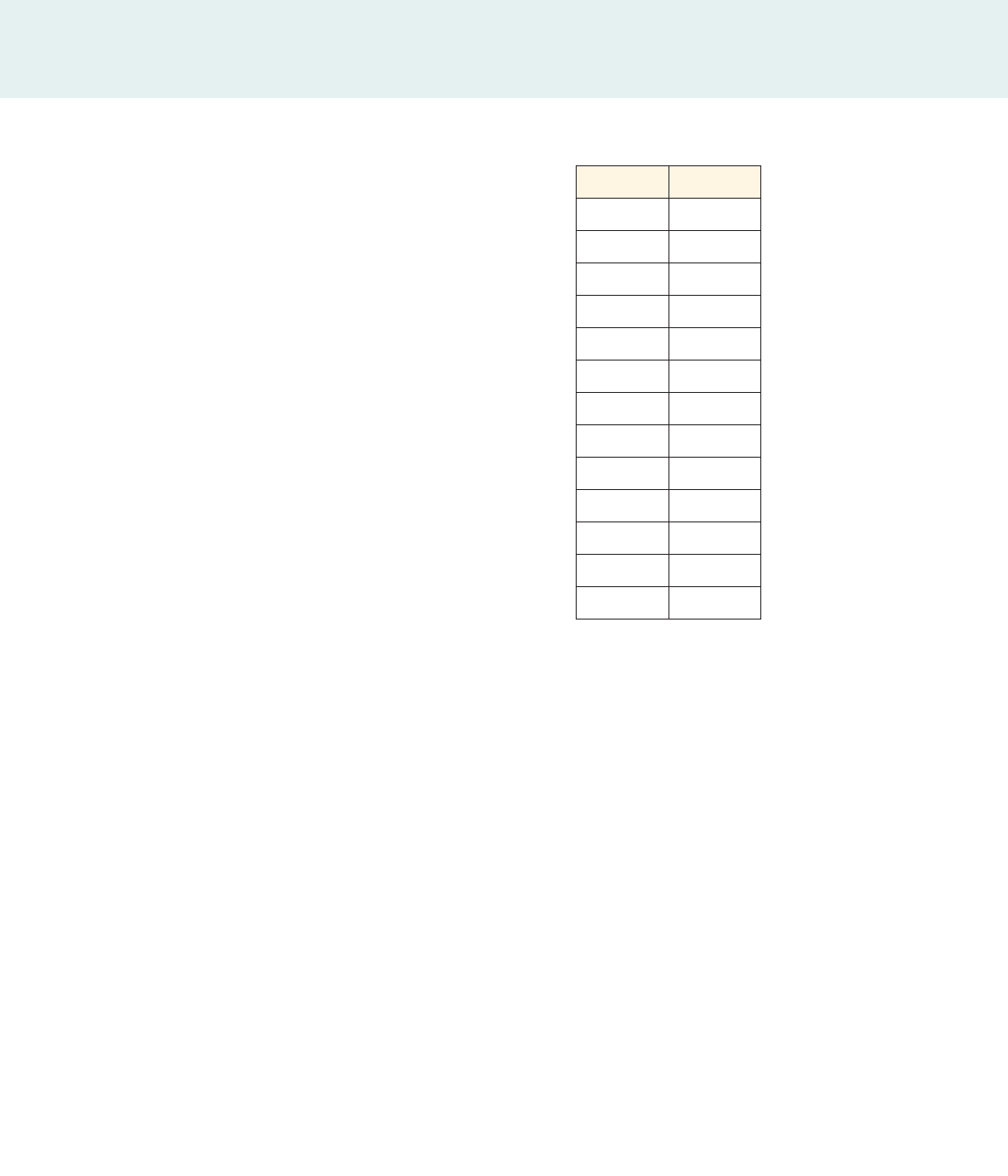
2. The lowest-sounding key on a piano is an A (called A0 or Double Pedal A).
This key produces a note four octaves below middle A (A440).
(a) What fundamental frequency does the lowest piano key have?
(b) Many people lose the ability to hear low frequencies as they age. Elderly
people often can’t hear frequencies lower than 40 Hz. Will they be able to
hear the fundamental tone produced by the A0 key?
3. The highest A on the piano is A7, three octaves above middle A (A440). The
highest-sounding key of all on the piano is the 88th, called C8. Its frequency is
three semitones above A7.
(a) What is the frequency of A7?
(b) What is the frequency of C8, the highest key on the piano?
(c) All people with normal hearing can hear sounds up to at least 15,000 Hz.
Can these people hear the sound of the highest key on the piano?
II. Intervals, Frequencies, and Dissonance
The “equally tempered” tuning of modern instruments described above did not come
into wide use until the late 17th century. Before that, musicians used many tunings
that sounded good to their ears and to their listeners’. Johann Sebastian Bach pub-
lished a set of preludes and fugues in 1722, called The Well-Tempered Clavier, which
was designed to popularize the new tuning system for keyboard instruments. Each
of the pieces in this work was written in one of the 24 major and minor keys in the
“well-tempered” tuning. Some listeners found the new tuning harsh and unmusical
for reasons that we now explore.
EXPLORATIONS
■
EXPLORATIONS
■
EXPLORATIONS
■
EXPLORATIONS
EXPLORATIONS 411
Key Frequency
A
440.000
A# B
466.164
B
C
C# D
D
D# E
E
F
F# G
G
G# A
A

1. When two or more keys on the piano are pressed simultaneously, the resulting
mixed sound is called a chord. When the ratios of the frequencies of the notes
in the chord involve small numbers, such as 2:1, 3:2, or 4:3, the chord sounds
pleasant and musical to most ears. But other ratios may sound unpleasant or
dissonant.
(a) A perfect fifth is an interval in a chord between two notes whose frequen-
cies are in the ratio 3/2. On the piano, this is approximated by two notes
that are seven semitones apart (for instance, C and G). Use your table
from Problem I.1 to determine the ratio between the frequencies of G and
C. How far does this differ from the ideal ratio of 3/2?
(b) A perfect fourth is an interval between two notes with frequencies in the
ratio 4/3. On the piano a fourth is approximated by two notes that are five
semitones apart (for instance, C and F). What is the ratio between the
frequencies of F and C on the piano? How far does this differ from the
ideal ratio of 4/3?
(c) Why do you think some people who are accustomed to perfect fifths and
fourths might find the modern tuning of a piano to be dissonant?
2. In an octave the two notes have a frequency ratio of 2/1. So to divide an octave
into 12 semitones, the frequency of each note is times the frequency of
the preceding note:
(a) In a perfect fifth the two notes have a frequency ratio of 3/2. If we divide a
perfect fifth into seven semitones, explain why the frequency of each note is
times the frequency of the preceding note:
(b) In a perfect fourth the two notes have a frequency ratio of 4/3. To divide a
perfect fourth into five semitones, by what factor must the frequency of
each note be multiplied to get the frequency of the next note?
(c) Calculate the factors in parts (a) and (b), and note that they are not equal.
Explain why this means that we can’t tune a piano (with even tempering)
so that it has exact perfect fifths as well as exact perfect fourths.
frequency of note = a
ⵧ
ⵧ
b
ⵧ
* frequency of preceding note
frequency of note = A
3
2
B
1>7
* frequency of preceding note
13>22
1>7
frequency of note = A
2
1
B
1>12
* frequency of preceding note
2
1>12
412 CHAPTER 4
EXPLORATIONS
■
EXPLORATIONS
■
EXPLORATIONS
■
EXPLORATIONS

413
Secret connections? When a volleyball is hit, it goes flying through the air,
but it always comes back down. The function that describes how the volleyball
travels is a quadratic function—it’s the function that describes how gravity
pulls down on objects. Of course, this same function also determines how high
a rocket reaches or how your keys fall when they are dropped. But we’ll see in
this chapter that a quadratic function also models how long your car tires will
last (as a function of the tire pressure) or how much grain a farm produces (as
a function of the amount of rainfall). So what’s the connection between the
volleyball and crop yield? The connection is a secret that has been discovered
by using algebra. The volleyball goes up and then down, but so does crop
yield; the more rain, the more crop is produced—up to a point. If there is too
much rain, crop yield begins to decrease. That these very different processes
can be described by the same type of function is the secret to the usefulness of
algebra.
5.1 Working with Functions:
Shifting and Stretching
5.2 Quadratic Functions
and Their Graphs
5.3 Maxima and Minima: Getting
Information from a Model
5.4 Quadratic Equations: Getting
Information from a Model
5.5 Fitting Quadratic Curves
to Data
EXPLORATIONS
1
Transformation Stories
2 Torricelli’s Law
3 Quadratic Patterns
Quadratic Functions
and Models
© image100/Corbis
